SOME ODDBALL GUNS
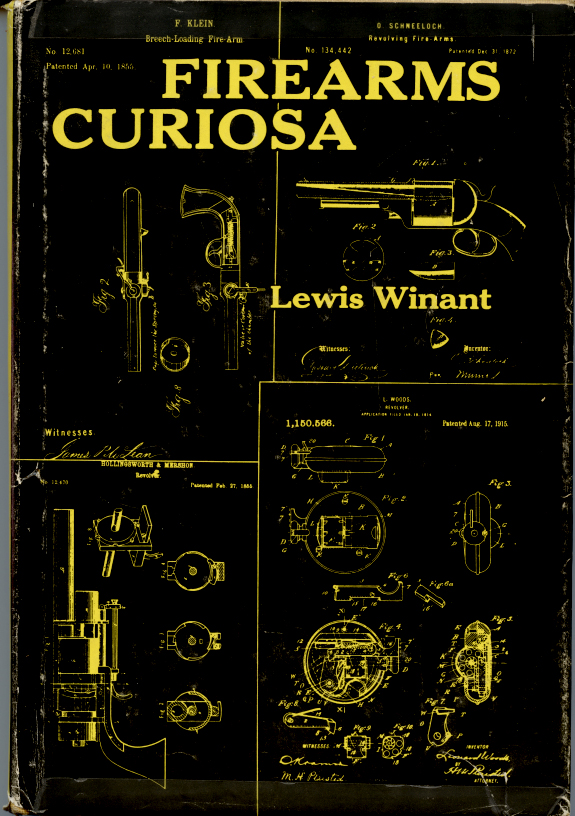 In my collection of books about shooting and firearms I have an odd and pretty rare volume entitled Firearms Curiosa by Lewis Winant, shown here at left. It’s a compendium of various firearms—both actual and proposed in the form of patents—that could well be characterized as “curious” or “odd,” and some of them can clearly be considered pointless or useless. I can’t—and won’t attempt to—reiterate Winant’s scholarly study here, but if anyone’s interested in this exhaustive work, I’d urge you to try to find a copy.
In my collection of books about shooting and firearms I have an odd and pretty rare volume entitled Firearms Curiosa by Lewis Winant, shown here at left. It’s a compendium of various firearms—both actual and proposed in the form of patents—that could well be characterized as “curious” or “odd,” and some of them can clearly be considered pointless or useless. I can’t—and won’t attempt to—reiterate Winant’s scholarly study here, but if anyone’s interested in this exhaustive work, I’d urge you to try to find a copy.
But some time ago I came across a gun on an auction site that struck me as, well, laughable if not entirely useless. So I’d like to look at some guns that could charitably be considered as marginal at best.
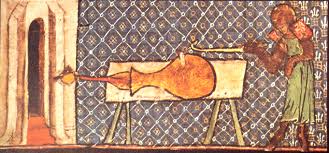 Firearms date from the 14th Century: the first illustration of a cannon (firing an arrow) dates from about 1365. By 1500, the “hand gonne”—a man-portable tube stuffed with powder and lead and fired by touching a match to it—was at least a theoretically practical weapon. Approximately fifteen minutes after the first “hand gonne” was fabricated, someone decided it would be a very handy thing to attach to a blade, or vice versa. Thus the combination of knives and guns was born, and miscellaneous iterations of this concept have recurred on a more or less daily basis since then.
Firearms date from the 14th Century: the first illustration of a cannon (firing an arrow) dates from about 1365. By 1500, the “hand gonne”—a man-portable tube stuffed with powder and lead and fired by touching a match to it—was at least a theoretically practical weapon. Approximately fifteen minutes after the first “hand gonne” was fabricated, someone decided it would be a very handy thing to attach to a blade, or vice versa. Thus the combination of knives and guns was born, and miscellaneous iterations of this concept have recurred on a more or less daily basis since then.
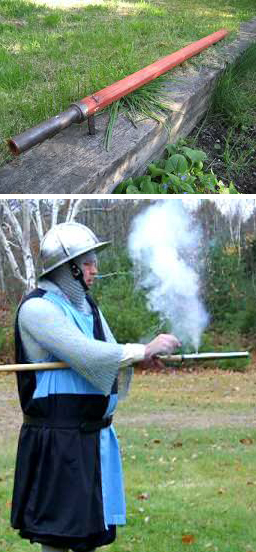 One such that would actually have been a fairly useful thing to have in a fight is shown below: the Elgin Cutlass Pistol. A big-bore single-shot handgun was more or less standard weaponry for sailors in boarding parties during “The Age of Wooden Ships and Iron Men,” as was a cutlass. The problem with a single shot pistol is that it’s only got a single shot…and then it’s just an encumbrance. Images of pirates with several pistols stuck in their sashes reflect this. If you have two guns you have two shots, right?
One such that would actually have been a fairly useful thing to have in a fight is shown below: the Elgin Cutlass Pistol. A big-bore single-shot handgun was more or less standard weaponry for sailors in boarding parties during “The Age of Wooden Ships and Iron Men,” as was a cutlass. The problem with a single shot pistol is that it’s only got a single shot…and then it’s just an encumbrance. Images of pirates with several pistols stuck in their sashes reflect this. If you have two guns you have two shots, right?

Well, two shots is nice but after you’ve killed two men, there are likely to be many more who have to be dealt with as you and your shipmates swarm the enemy’s vessel and engage in hand-to-hand fighting. That’s where a cutlass is useful: slash, chop, slash, chop, and you never run out of ammunition.
So why not combine the two? Once you’ve offed an enemy sailor with your single round, you can start hacking and hewing at the others; and not incidentally defend yourself against their attacks. So Elgin (and some others) developed a large pistol with an attached cutlass blade to fill this niche. In my opinion—keeping in mind that I’ve never boarded an enemy vessel to engage in hand-to-hand combat—this would indeed be a comforting thing to be armed with in such circumstances. BANG! SLASH! Is better than BANG! CLICK! Oops…
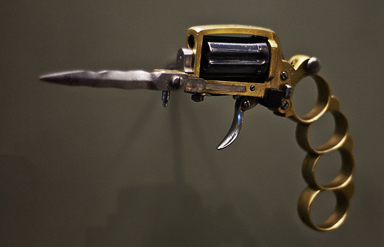 Continuing with the theme of combining various types of offensive weapons, we see it more or less reach its zenith in the “Apache” pistol, shown here in all its unfolded glory. This is essentially a small-caliber pepper-box revolver combined with a stiletto and a set of nasty brass knuckles. These things were pretty popular among the criminal element in Paris (Les Apaches) in the late 19th Century for obvious reasons. The folding trigger could be moved out of the way and the blade folded back so you didn’t shoot or stab yourself while using the brass knuckles. Folded up it was also pretty easily concealed, an obvious virtue.
Continuing with the theme of combining various types of offensive weapons, we see it more or less reach its zenith in the “Apache” pistol, shown here in all its unfolded glory. This is essentially a small-caliber pepper-box revolver combined with a stiletto and a set of nasty brass knuckles. These things were pretty popular among the criminal element in Paris (Les Apaches) in the late 19th Century for obvious reasons. The folding trigger could be moved out of the way and the blade folded back so you didn’t shoot or stab yourself while using the brass knuckles. Folded up it was also pretty easily concealed, an obvious virtue.
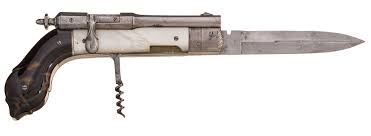 The French don’t only live in big cities: they enjoy a picnic in the countryside as much as any other people do. Being French, they’re also pretty practical; and no picnic is complete without a bottle of wine, now is it? So the gun-cum-knife theme found another niche as a tool for picnic parties, when it’s combined with—what else?—a corkscrew. The small knife shown here could be used for peeling and slicing a pomme as well as opening a bottle of vin rouge. The little bolt-action pistol attached to it would have been helpful if you were attacked by a stray dog or an Apache. Since the corkscrew also serves as the trigger, you'd have to be careful about using it. One would not want to accidentally shoot Tante Suzette while opening the vin.
The French don’t only live in big cities: they enjoy a picnic in the countryside as much as any other people do. Being French, they’re also pretty practical; and no picnic is complete without a bottle of wine, now is it? So the gun-cum-knife theme found another niche as a tool for picnic parties, when it’s combined with—what else?—a corkscrew. The small knife shown here could be used for peeling and slicing a pomme as well as opening a bottle of vin rouge. The little bolt-action pistol attached to it would have been helpful if you were attacked by a stray dog or an Apache. Since the corkscrew also serves as the trigger, you'd have to be careful about using it. One would not want to accidentally shoot Tante Suzette while opening the vin.
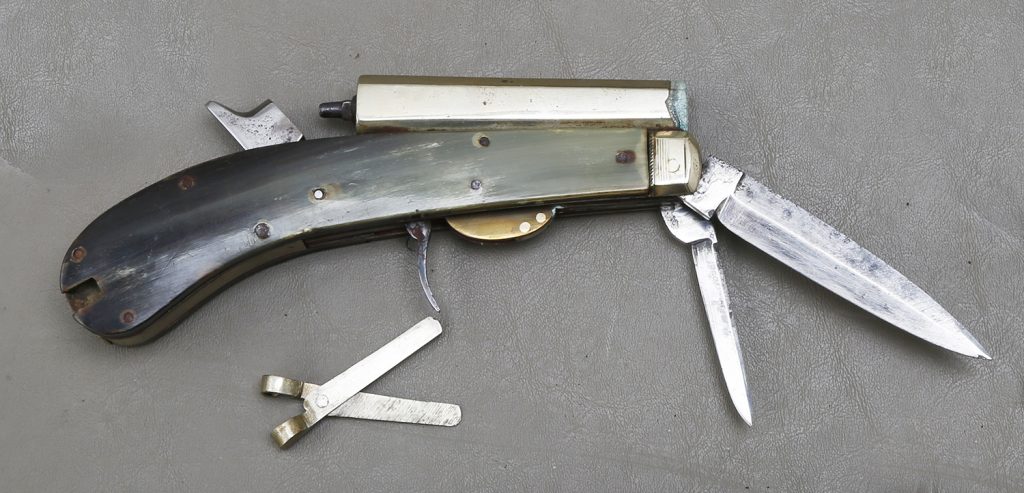
The “countrified” subset of knife guns includes the percussion-fired Unwin & Rogers shown at right. This one came complete with a little bullet mold and has two blades. One for peeling apples and one for gutting squirrels, I guess.
And there is the Peavey knife-pistol combo, which was, I think designed for trappers. I had a bit of a struggle trying to figure out how this one worked, so I’ll insert here the description I found on The Internet’s Fountain Of Universal Knowledge (a/k/a Google):
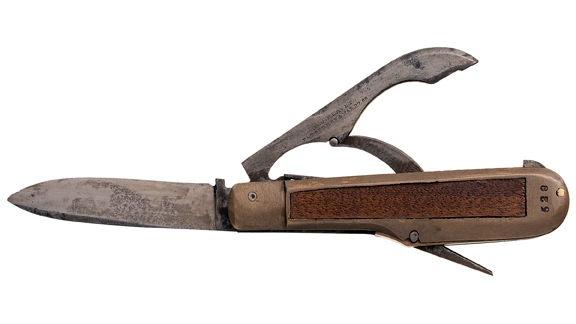
Developed in the 1860s by A.J. Peavey, the Peavey Knife Pistol is a multipurpose knife, pistol and alarm gun. In addition to the 2 5/8 inch knife blade and the conventional folding trigger, the pistol is pre-rigged to accept a trip line…for attachment to a door, window, chest or other moving object. Additionally, the patent form describes stabbing the knife blade into a door frame so the door will strike the trigger when opened as an alternate means of setting the trap. When opened, the item is 7 inches overall, with the pistol mechanism running the length of the body...
I have to differ with this description. No doubt it would be useful as a burglar alarm, as described (few things alert one to the presence of an intruder like a gunshot in the middle of the night, I agree)  but the tripline would also be useful if you attached it to some bait and set it up to fire a bullet into an animal tugging at it. You could then use the knife blade to skin your victim.
but the tripline would also be useful if you attached it to some bait and set it up to fire a bullet into an animal tugging at it. You could then use the knife blade to skin your victim.
I once owned the mousetrap gun shown at right, that worked something like it; although you were supposed to load the smoothbore barrel with a small blank charge of black powder (10 grains FFFg), a wad, and a percussion cap. (If you wanted to use a bullet a #1 buckshot would fit.) When a mouse or other small critter hits the bait, the hammer falls and BOOM! the mouse is immediately transferred to The Great Cheese Factory In The Sky. Ten grains of black powder going off in a mouse’s face would splatter parts him over the place. I never had the nerve to use it in the house (Mrs Outdoorsman would have been really unhappy) but it would have been useful in a hunting cabin or barn (if I owned either, which I don't; and assuming it wouldn’t set the hay on fire, which it very well might).
Here’s how it works:
https://www.youtube.com/watch?v=5m7V4hvcD6U
The video calls it a “mole gun,” but it was sold by Dixie Gun Works as a mouse trap. Alas, I no longer own this little gem, and in my hands no mouse ever Passed by its agency while I had it.
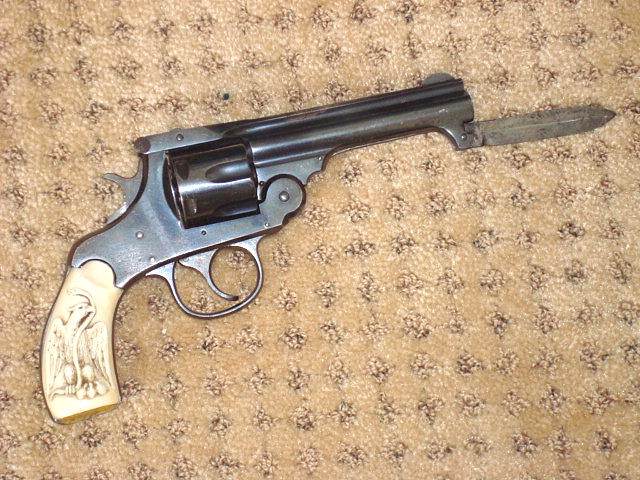
So now I come to the auction find that “triggered” (ha, ha) this essay. An H&R knife-pistol combining a 2-1/2 inch blade and a .32 S&W Short top-break revolver. Now, this gun was clearly intended to be used in self-defense, but if there is a more useless item for that purpose, I have yet to see it. The blade is no longer than that on a Boy Scout knife and the .32 S&W round is so feeble that bullets will literally bounce off anything hard. An assailant wearing a decent overcoat or jacket would be entirely immune to anything this gun could do. The old saying about not bringing a knife to a gunfight applies here, no question. Unless you stabbed the bad guy in the eye and fired the pistol at the same time, likely this would do you no good whatever in a tight spot.
|OPENING PAGE|
 In my collection of books about shooting and firearms I have an odd and pretty rare volume entitled Firearms Curiosa by Lewis Winant, shown here at left. It’s a compendium of various firearms—both actual and proposed in the form of patents—that could well be characterized as “curious” or “odd,” and some of them can clearly be considered pointless or useless. I can’t—and won’t attempt to—reiterate Winant’s scholarly study here, but if anyone’s interested in this exhaustive work, I’d urge you to try to find a copy.
In my collection of books about shooting and firearms I have an odd and pretty rare volume entitled Firearms Curiosa by Lewis Winant, shown here at left. It’s a compendium of various firearms—both actual and proposed in the form of patents—that could well be characterized as “curious” or “odd,” and some of them can clearly be considered pointless or useless. I can’t—and won’t attempt to—reiterate Winant’s scholarly study here, but if anyone’s interested in this exhaustive work, I’d urge you to try to find a copy.  Firearms date from the 14th Century: the first illustration of a cannon (firing an arrow) dates from about 1365. By 1500, the “hand gonne”—a man-portable tube stuffed with powder and lead and fired by touching a match to it—was at least a theoretically practical weapon. Approximately fifteen minutes after the first “hand gonne” was fabricated, someone decided it would be a very handy thing to attach to a blade, or vice versa. Thus the combination of knives and guns was born, and miscellaneous iterations of this concept have recurred on a more or less daily basis since then.
Firearms date from the 14th Century: the first illustration of a cannon (firing an arrow) dates from about 1365. By 1500, the “hand gonne”—a man-portable tube stuffed with powder and lead and fired by touching a match to it—was at least a theoretically practical weapon. Approximately fifteen minutes after the first “hand gonne” was fabricated, someone decided it would be a very handy thing to attach to a blade, or vice versa. Thus the combination of knives and guns was born, and miscellaneous iterations of this concept have recurred on a more or less daily basis since then.  One such that would actually have been a fairly useful thing to have in a fight is shown below: the Elgin Cutlass Pistol. A big-bore single-shot handgun was more or less standard weaponry for sailors in boarding parties during “The Age of Wooden Ships and Iron Men,” as was a cutlass. The problem with a single shot pistol is that it’s only got a single shot…and then it’s just an encumbrance. Images of pirates with several pistols stuck in their sashes reflect this. If you have two guns you have two shots, right?
One such that would actually have been a fairly useful thing to have in a fight is shown below: the Elgin Cutlass Pistol. A big-bore single-shot handgun was more or less standard weaponry for sailors in boarding parties during “The Age of Wooden Ships and Iron Men,” as was a cutlass. The problem with a single shot pistol is that it’s only got a single shot…and then it’s just an encumbrance. Images of pirates with several pistols stuck in their sashes reflect this. If you have two guns you have two shots, right? 
 Continuing with the theme of combining various types of offensive weapons, we see it more or less reach its zenith in the “Apache” pistol, shown here in all its unfolded glory. This is essentially a small-caliber pepper-box revolver combined with a stiletto and a set of nasty brass knuckles. These things were pretty popular among the criminal element in Paris (Les Apaches) in the late 19th Century for obvious reasons. The folding trigger could be moved out of the way and the blade folded back so you didn’t shoot or stab yourself while using the brass knuckles. Folded up it was also pretty easily concealed, an obvious virtue.
Continuing with the theme of combining various types of offensive weapons, we see it more or less reach its zenith in the “Apache” pistol, shown here in all its unfolded glory. This is essentially a small-caliber pepper-box revolver combined with a stiletto and a set of nasty brass knuckles. These things were pretty popular among the criminal element in Paris (Les Apaches) in the late 19th Century for obvious reasons. The folding trigger could be moved out of the way and the blade folded back so you didn’t shoot or stab yourself while using the brass knuckles. Folded up it was also pretty easily concealed, an obvious virtue.  The French don’t only live in big cities: they enjoy a picnic in the countryside as much as any other people do. Being French, they’re also pretty practical; and no picnic is complete without a bottle of wine, now is it? So the gun-cum-knife theme found another niche as a tool for picnic parties, when it’s combined with—what else?—a corkscrew. The small knife shown here could be used for peeling and slicing a pomme as well as opening a bottle of vin rouge. The little bolt-action pistol attached to it would have been helpful if you were attacked by a stray dog or an Apache. Since the corkscrew also serves as the trigger, you'd have to be careful about using it. One would not want to accidentally shoot Tante Suzette while opening the vin.
The French don’t only live in big cities: they enjoy a picnic in the countryside as much as any other people do. Being French, they’re also pretty practical; and no picnic is complete without a bottle of wine, now is it? So the gun-cum-knife theme found another niche as a tool for picnic parties, when it’s combined with—what else?—a corkscrew. The small knife shown here could be used for peeling and slicing a pomme as well as opening a bottle of vin rouge. The little bolt-action pistol attached to it would have been helpful if you were attacked by a stray dog or an Apache. Since the corkscrew also serves as the trigger, you'd have to be careful about using it. One would not want to accidentally shoot Tante Suzette while opening the vin. 

 but the tripline would also be useful if you attached it to some bait and set it up to fire a bullet into an animal tugging at it. You could then use the knife blade to skin your victim.
but the tripline would also be useful if you attached it to some bait and set it up to fire a bullet into an animal tugging at it. You could then use the knife blade to skin your victim.